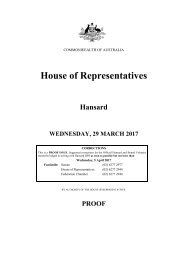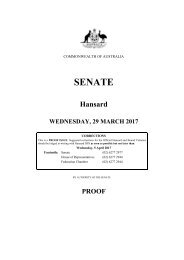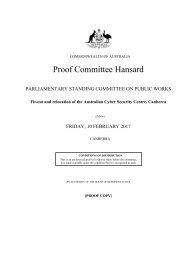SENATE
2e7N9wg
2e7N9wg
Create successful ePaper yourself
Turn your PDF publications into a flip-book with our unique Google optimized e-Paper software.
78 <strong>SENATE</strong> Thursday, 13 October 2016<br />
The Government therefore supports a more targeted approach to addressing the use of smoke alarms by the states and<br />
territories via the ABCB and through the NCC.<br />
Foreign Affairs, Defence and Trade References Committee<br />
Report<br />
Senator GALLACHER (South Australia) (15:41): I present the report of the Foreign Affairs, Defence and<br />
Trade References Committee on the planned acquisition of the Joint Strike Fighter, together with the Hansard<br />
record of proceedings and documents presented to the committee.<br />
Ordered that the report be printed.<br />
Senator GALLACHER: I move:<br />
That the Senate take note of the report.<br />
I am pleased to table this report of the Foreign Affairs, Defence and Trade References Committee into the planned<br />
acquisition of the F-35 Lightning II Joint Strike Fighter. Government, opposition, Australian Greens and the Nick<br />
Xenophon Team senators worked cooperatively during this inquiry, and I am pleased that the majority report<br />
recommendations have the support both of the government and the opposition.<br />
The committee is satisfied that the F-35A is the only aircraft able to meet Australia's strategic needs for the<br />
foreseeable future, and that sufficient progress is being made in the test-and-evaluation program to address<br />
performance issues of concern. However, the committee is not convinced that any of the available alternative<br />
aircraft raised in evidence are capable of meeting Australia's air defence needs.<br />
Nonetheless, in light of the serious problems that have led to the re-baselining of the F-35 program in 2012 and<br />
the ongoing issues identified by the United States Director, Operational Test and Evaluation, the committee<br />
retains a healthy scepticism towards assurances by Defence regarding cost, schedule and capability outcomes for<br />
the F-35.<br />
The report makes three key recommendations for Defence and the government, focusing on: (1) the<br />
development of a hedging strategy to address the risk of a capability gap resulting from further delays in the<br />
acquisition of the F-35A; (2) the development of a sovereign industrial capability strategy for the F-35A to ensure<br />
that Australian aircraft can be maintained and supported without undue reliance on other nations; and (3) the<br />
establishment of Australia as the Asia-Pacific maintenance and sustainment hub for the F-35.<br />
There have been significant changes to the acquisition schedule over the life of the F-35 program, including the<br />
recent re-baselining in 2012 and the limited scope and considerable cost to further extend the life of the Classic<br />
Hornet fleet. The committee therefore considers it prudent for Defence to develop a hedging strategy to mitigate<br />
the risk of a capability gap resulting from further delays.<br />
The support solution for sustainment is still under development. However, the F-35's reliance on mission data<br />
loads produced by the US Reprogramming Laboratory, together with the Autonomic Logistics Information<br />
System and the global support model could impact on Australia's sovereign ability to make decisions around how,<br />
when and where we deploy capability.<br />
The potential for other nations to be prioritised over Australia for the provision of repair parts and for the<br />
development of software—for example, mission data files and electronic warfare—may negatively impact on<br />
Australia's capability. A balance must be found between the benefits of the global support solution and preserving<br />
an acceptable level of sovereignty regarding the maintenance of Australia's capability. As such, the committee<br />
strongly supports Defence's efforts to develop mission data reprogramming capabilities in Australia. Further, the<br />
committee encourages efforts to establish Australia as the F-35 Asia-Pacific maintenance and sustainment hub.<br />
This would have the dual benefit of increasing Australian industry participation in the F-35 global support<br />
solution as well as developing in-country maintenance and support capabilities.<br />
The F-35 program has had a positive impact on Australian industry and indeed the Australian economy. As a<br />
result of being able to compete for business in global F-35 program supply chains, and with the support of<br />
government programs, Australian companies have won a number of significant contracts and secured over<br />
US$554 million worth of design and production work. This figure is expected to increase significantly over the<br />
life of the program as it matures, resulting in rising production volumes and future sustainment opportunities.<br />
Australian industry submitters and witnesses told the committee they have received a range of benefits from<br />
their involvement in the F-35 program, including: capability and network development; job creation; long-term<br />
investment; increased skills and experience; and opportunities for future work. The committee was pleased to hear<br />
that the F-35 program has delivered considerable employment opportunities to Australian industry as well as<br />
helping to offset declining employment rates—in particular, in the automotive manufacturing industry—by<br />
engaging a large number of people out of its engineering and manufacturing workforce.<br />
CHAMBER















